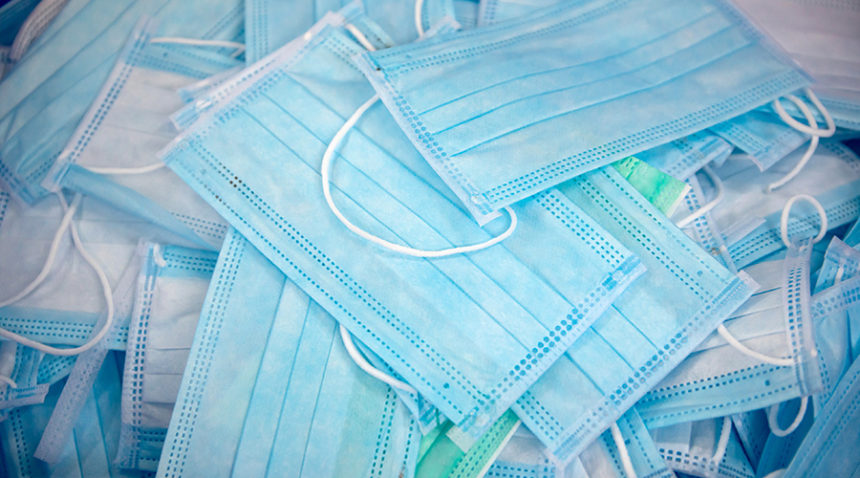To double mask or not? That might be the question on your mind after all the recent buzz about whether wearing two masks helps better protect against the spread of coronavirus disease 2019 (COVID-19), especially new variants of the virus.
The answer is: Layering masks, such as a surgical mask under a cloth mask, can improve your protection, as can wearing a cloth mask with multiple layers. The fit of your mask is crucial—you’ll want to minimize gaps around your nose, cheeks and chin.
You don’t want to layer two surgical/disposable masks, which tend to be loose-fitting, or a KN95 mask with any other type of mask. That you should wear on its own.
The Centers for Disease Control and Prevention (CDC) has released new guidance about layering masks, and researchers at UNC have been studying the issue themselves.
To learn more, we talked to Emily Sickbert-Bennett, PhD, director of UNC Medical Center Infection Prevention. Here are four things we learned.
1. The best protection is for everyone to wear a mask.
Forget the number of layers for a moment; the best protection is for everyone to simply wear a mask.
“The best form of ‘double masking’ is when you and the person you’re interacting with are both masked with a mask that completely covers the nose and mouth,” Dr. Sickbert-Bennett says. “When masks are consistently worn, then transmission is halted. The science is clear on that, and as a society, that’s going to be our most important way to get transmission to stop.”
2. The better the fit, the better the protection.
The CDC says a tight fit, with the least air leaking from around the mask, is key to keeping virus droplets out. To that end, experts recommend choosing a mask with a nose wire or wearing a mask fitter or brace that goes over the mask to hold it against the face.
UNC School of Medicine researchers tested the efficacy of masks against the spread of the virus in their aerosol lab, Dr. Sickbert-Bennett says.
“One thing they found was that if you put on two ear-loop surgical masks, like we use in the hospital settings for hospital workers, it really doesn’t provide an additional benefit by itself,” Dr. Sickbert-Bennett says. “But what we do know is that improving the fit of the ear-loop mask is really the most important thing.”
Improving the fit has been shown to increase the effectiveness of the mask up to 20 percent, Dr. Sickbert-Bennett says. “Rather than layering up two masks that have the identical fit, it would be better to focus on improving the fit by tying the ear loops and tucking in the side pleats.”
Keep in mind, mask brackets worn underneath the masks decrease the effectiveness of your mask—they loosen your mask’s fit, causing it to fit less tightly to your face.
3. A cloth mask on top of a surgical mask improves fit and effectiveness.
Medical-grade N95 respirators block out at least 95 percent of particles when worn correctly, but N95s remain in short supply, and the Centers for Disease Control and Prevention says they should be reserved for healthcare workers.
“The material in medical procedure masks is designed to provide really good filtration,” Dr. Sickbert-Bennett says. “But the downside of them is that they aren’t designed to fit your face very tightly. So making sure they fit your face tightly is really important.”
Pairing a medical procedure masks under a cloth mask that’s widely available to the public can also improve the fit and filtration when you are out in the community, Dr. Sickbert-Bennett says.
“The cloth mask helps provide an anchor and close some of the gaps, and the surgical mask offers consistent filtration underneath the cloth mask,” Dr. Sickbert-Bennett says. Again, don’t double up on surgical masks, and if you have a KN95, that should be worn alone.
4. Choose cloth masks with multiple layers and/or a filter.
Multiple layers of fabric add extra protection, according to the CDC. Some masks come with a filter pocket; you can use HEPA filters that are typically used in air purifiers.
Also, when choosing a cloth mask, find one with a tight weave. Studies have found that masks made with 100 percent cotton are a good choice.
For the latest information on COVID-19, visit the CDC website and the UNC Health COVID-19 Resources page, and follow UNC Health on Twitter, Facebook, Instagram and YouTube.
Photo credit: © Bloomberg Creative – gettyimages.com

